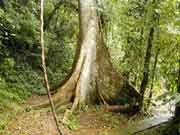 |
|
Beautiful Dai Girls |
|

|
Xishuangbanna situates in the Southwest frontier of China. It is a land of miracles and a district that cultivates unique national forest cultures.
Xishuangbanna is miraculous in many aspects. It situates in the remote Southwest frontier of China, borders with Laos and Burma, and is close to Southeastern Asian countries such as Thailand and Vietnam. “The Danube of Asia – Lancang River enters this district from its northwest and transverses the whole territory, and then it inflows to the boundary in-between China, Laos and Burma from the its southeast; then, it turns south into the famous “golden triangle” in-between Laos, Burma and Thailand; and it confluxes in Cambodia and Vietnam and inflows into the South China Sea.
Xishuangbanna is a Dai name for this place. It means 12 taxpaying units. It has its name in Ming Dynasty (1570), so it has a history of at least several hundred years.
Xishuangbanna experienced the change of “seas into crop fields”. In the geological history, the part in the west of the Lancang River in Xishuangbanna was once part of the ancient Mediterranean, because the floating of the continental blocks, the Indian Block inserted into the Asia-Europe Block; thus, caused the Himalayan mountain creating movement. After the ancient Mediterranean retreated, Xishuangbanna became part of the continent, and its elevation also hoisted. Nowadays, we could still see dozens of plants originally grow along the seas, such as mangrove forest, and they have become witnesses of such drastic changes.
 |
 |
|
seas change into mulberry fields
and mulberry fields into seas |
buttressus root |
Xishuangbanna is unique. It is a place where the Dai,
Hani, Yao, Bulang and Jinuo minorities live in compact communities. All minorities are very chaste and honest; they have peculiar beliefs and cultures, long-standing traditional arts and full-bodied national customs.
In ancient times, Xishuangbanna was known for its “farming by elephants”, “the land that rides elephants” and “tattoos”. In the modern period, it is famous for films such as “Moya Dai” and “In the Rain Forest of
Xishuangbanna” as well as its peacock dances. Though it is still hard for the historical records to prove who lived in this part in remote times, one point is sure. Hundreds of years ago, the ancestors of the Dai minority and other minorities have settled here, and they created a resplendent history and culture. In the Chinese documentary records of 2000 years ago, the people of the inland called this place the “land that rides on the back of elephants”; and since the local people used elephants in farming, the place was also known for “farming by elephants”. But how could elephant farm? Do they pull the ploughs like bulls? Of course not. The local folks would only chase the elephants to the field
and let them trample on the field, i.e. “first, the elephant trample the soil, then, birds would eat the grains and grasses on the surface of the soil; when all the grasses and grains are eaten, the earth is like that it have been ploughed. The earth become loosen, and the people begin to plant”. It sound like a marvelous story. The local folks also used elephant for battles in ancient time. In the history, the chiefs of Xishuangbanna all submitted to the dynasties in the inland of China, and they used to present tamed elephants and trunks to the feudal leaders; the trunks were used to carve various ornaments and thus joined the traditional inland culture. On the other hand, the communication with inland China promoted the development of the local communities and made them become members of the Chinese nation.
 |
|
The General Buddhist Temple
in Xishuangbanna |
Xishuangbanna has many unique landscapes. For example, the Five Buddhism Trees and the Six Buddhism Flowers are planted everywhere; they have elephants and peacocks, as well as numerous temples and Buddhist pagodas.
Among all these special features, except the temples and pagodas, all other things are closely related with the rain forest, and thus form a unique culture for the region.
Xishuangbanna is unique in that, all the minorities
living in the vast forests rely on the rain forests for their materials needed in the process of their survival and development, including the plant and animal resources of the forests; therefore, we could call them “nations of the forests”. These minorities interact with the forests, and their cultural and spiritual life also reflect their relations with the forests and environment. The Dai folks believe: “there would be no water without forest, there won’t be any fields without water; there would be no grains without fields, and there wouldn’t be any man without grains”.
Such chaste natural biological point of views are recorded in all Dai and Chinese documents, and are also passed down through legends, poems, folklores, and proverbs to later generations; besides, we could also find
such attitudes in their production activities, living customs, religious beliefs and cultural activities. This is a special strategy adopted by them under the special circumstances of the forests. In this way, they preserved 50% to 60% of natural forest coverage until the 1950s.
 
|

